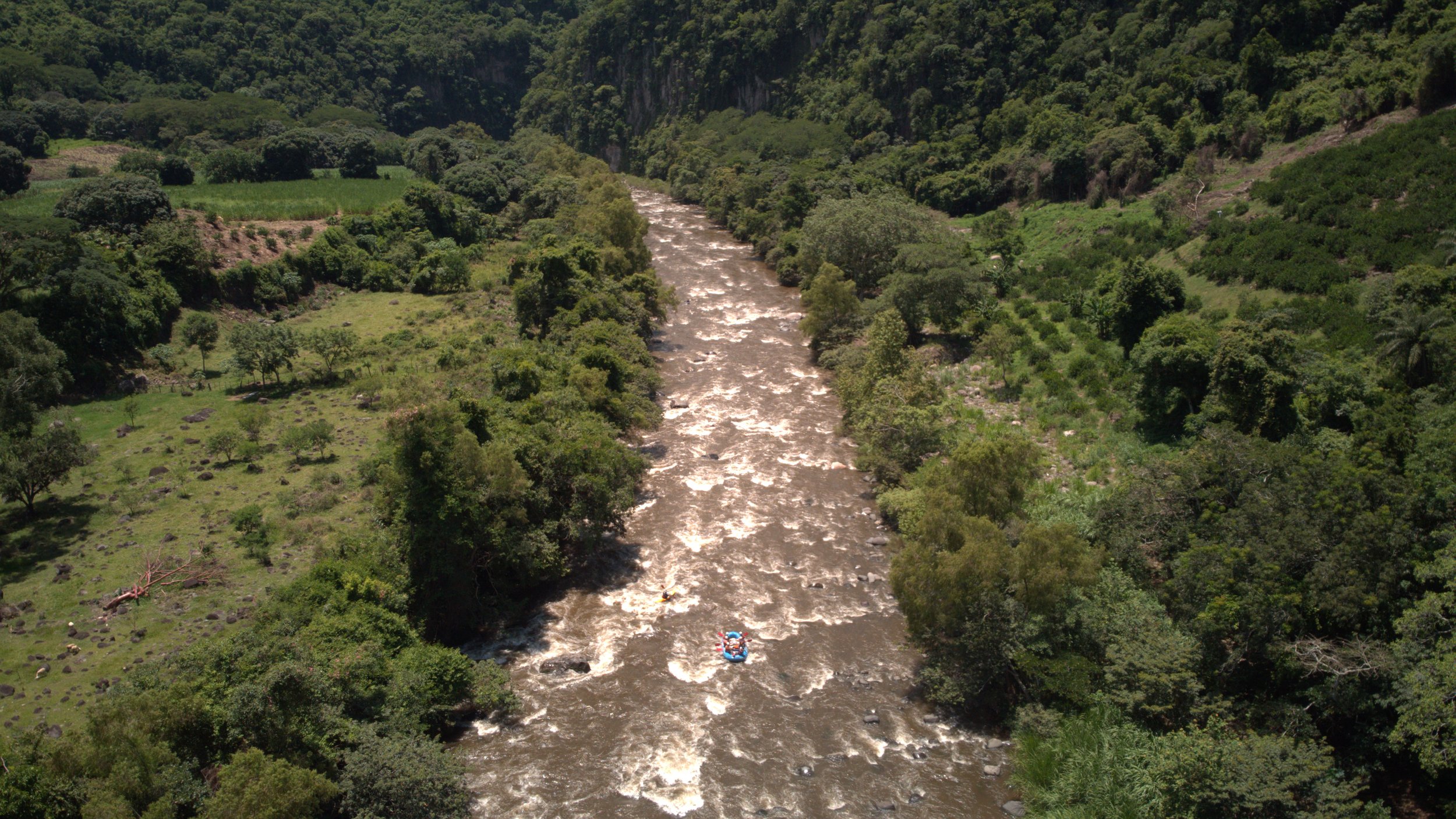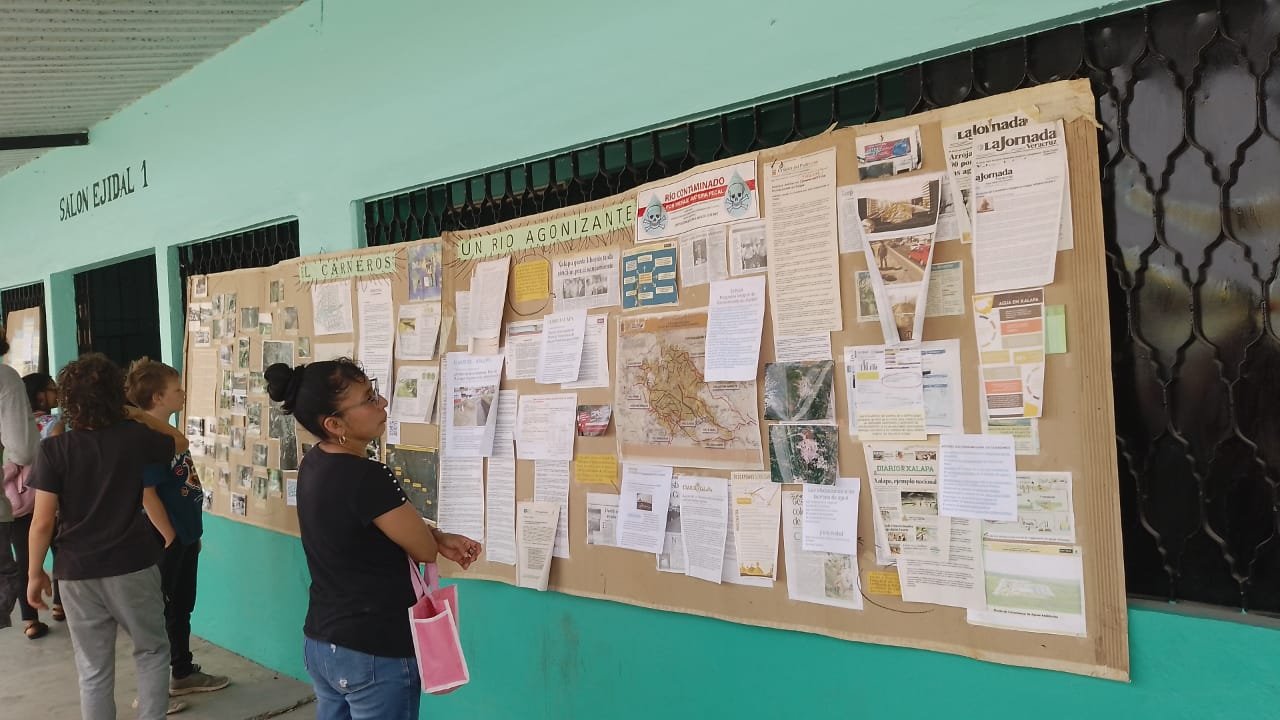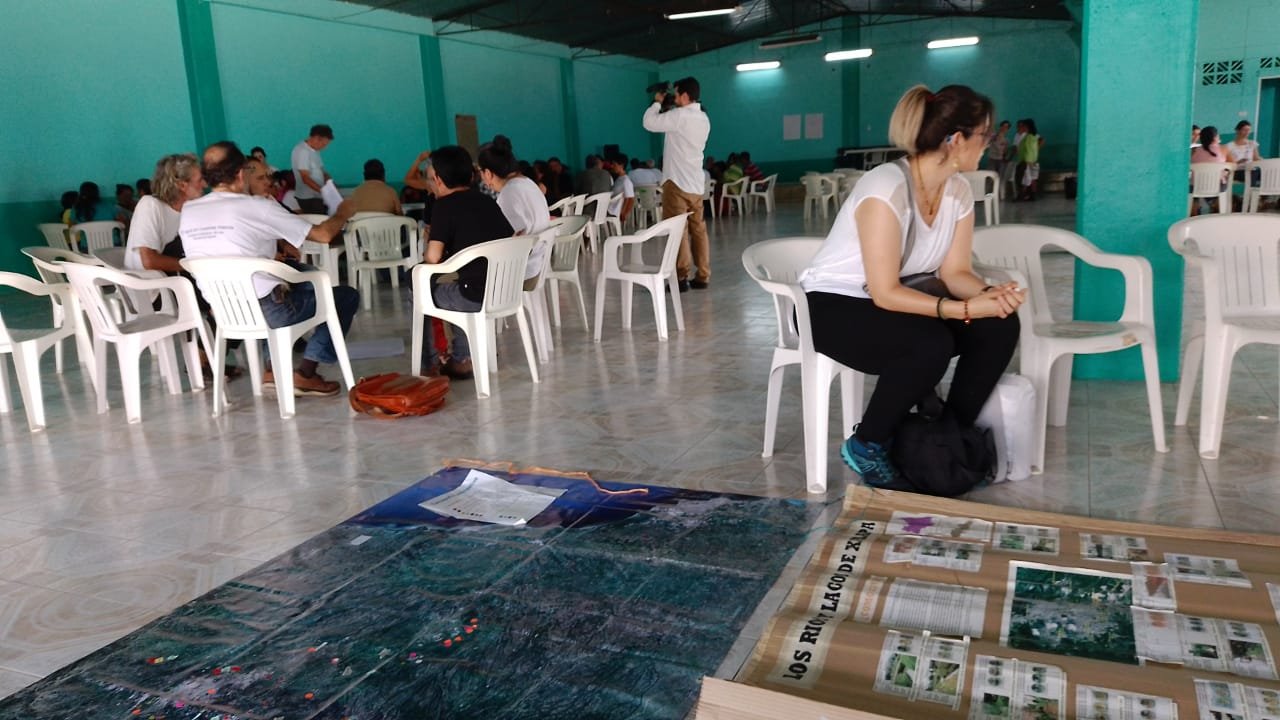Resistance Flows On: Mexico’s Water Defenders Unite Their Efforts Once Again
Image Source: Alejandro Gallardo
The Fifth Community Assembly for Water (La Quinta Asamblea Comunitaria por el Agua) was held on Friday, May 5, 2023, in Pacho Viejo, Veracruz, Mexico. Pacho Viejo seems an apt location for a convention on the protection and conservation of la Cuenca la Antigua (the Antigua Watershed). It is in the geographic heart of this river basin, situated between the cities of Xalapa, the capital of Veracruz, and Coatepec, often called “the Coffee Capital of Mexico.” This assembly of Sentinelas de rio (River Sentinels) represented a convergence of undercurrents running beneath the region’s rich culture, ongoing political strife, and incredible biodiversity, all flowing toward safeguarding the ultimate source of life: water.
A Vibrant and Fragile Region
A map showing the distinct rivers of the watershed as well as several damming, diversion, and hydroelectric projects that existed or were being planned in the area as of 2014. (Image source: SubVersiones.org.)
"Map of priority maritime regions of Mexico.” La Antigua River is number 79. (Image source: Biodiversidad Mexicana.)
Mexico’s Conabio (National Commission for the Knowledge and Use of Biodiversity) first designated el Río Antigua as a “priority hydrological region” in 1998. 110 regions were prioritized either for their use, high level of biodiversity, threatened status, or biological importance. The Antigua Watershed was one of 75 regions prioritized for conservation and sustainable management due to their high level of biodiversity.
The main river in the basin is the Huitzilapan river, which means “Hummingbird” in Nahuatl and is also known as “la Antigua'' in Spanish. It begins at an extinct volcano known by its Nahuatl name Naucampatépetl (and in Spanish as Cofre de Perote) and flows through the state of Veracruz and ultimately into the gulf of Mexico. Xalapa, Coatepec, Teocelo, Jalcomulco, Los Pescados, and La Antigua are identified as major towns or cities through which the river passes. The basin’s temperate climate fosters the growth of complex ecosystems, including the region’s impressive and equally vulnerable “cloud forests.” Fog rolling in from the ocean becomes trapped by these cloud forests at the base of mountain ranges, creating a rich, humid environment for the area’s flora, fauna, and rivers to flourish.
Image Source: Talking Wings Collective.
Mexico’s History of “Development” Projects
The defenders of La Cuenca Antigua, particularly those from Indigenous pueblos, know all too well that fragile, biodiverse regions are often exploited for their abundance of resources. The shores of the Antigua River have long borne witness to the development of mango and lemon orchards, sugarcane and coffee plantations, mining operations, and dams erected for hydroelectric projects.
Mexico has a storied history of development projects, particularly those focused on damming and hydropower. The Cerro de Oro dam, for example, was built by the federal government in Tuxtepec, Oaxaca in 1989. The dam was built for flood control purposes, but also to increase the power generation of the neighboring Miguel Alemán dam by combining its reservoir with that of Cerro de Oro. The project forcibly displaced 26,000 Indigenous Chinantec people who were never fairly compensated by the Mexican government despite its promises to provide the displaced community with land equal in size and quality to what they had lost.
20 years later, in 2010, the U.S. government agency Overseas Private Investment Corp (OPIC) funded the construction of a multi-million dollar hydroelectric plant adjacent to the Cerro de Oro dam. Once OPIC broke ground, a string of logging operations and water contamination issues sparked the concern of the area’s residents, including farmers who rely on clean water for their livelihoods. Complaints were filed on behalf of multiple local pueblos, forcing OPIC to negotiate with the Indigenous communities and leading to the formation of three separate agreements and a dam safety investigation. Ultimately, construction on the dam was halted in February 2011 and never resumed.
Birth of the PUCARL Collective
The region’s fraught relationship with these attempts at “development” speaks to the irrefutable power of resistance as much as it does to the influences of corporate interests and settler colonial ideology. Los Pueblos Unidos de la Cuenca Antigua por los Ríos Libres (Communities of the Antigua Watershed United for Free Rivers, or the PUCARL Collective), one of the most prominent and successful groups defending the Antigua Watershed today, was born out of unified efforts of many communities to halt the construction of another harmful dam in the river basin in 2014. The many different people and groups who came to form the collective were persuaded to join their efforts not only by the severity of the threat to their lands and communities, but also by the opportunity to continue a legacy of resistance.
Longtime activist and member of the PUCARL Collective Alejandro Gallardo of Jalcomulco remembers the events well. Amidst swirling rumors and unrest in 2010, Gallardo and other concerned citizens of Jalcomulco gradually began the task of organizing their community, mainly through information sharing and making connections with those located in larger cities such as Xalapa. The most alarming rumor that community members were trying to make sense of was that the Mexican government had approved plans for a powerful construction company to erect a hydroelectric dam in the Río Pescados (River of Fish). The Río Pescados and the Huitzilapan both attract tourists from all over who come to kayak and raft in their rapids. In fact, the Rio Pescados is home to Mexico’s national rafting team.
Rafters on the Huitzilapan River. (Image Source: Alejandro Gallardo.)
The Río Pescados supports the community of Jalcomulco beyond the economic benefit of tourism in ways that are difficult to quantify but are easily understood by locals. It is where the local children play and learn to swim; where fishermen catch prawns to be cooked in local restaurants; where life itself begins. The dam was meant to divert water to Xalapa, which would reduce the Río Pescados to little more than a stream while simultaneously flooding other nearby areas. The impacts on local crops and communities which rely on the river to sustain themselves would be devastating. Plus, the energy produced by the dam would be sold at an exorbitant price, the benefits of which the people of the Antigua river basin would never see.
Continuing a Legacy of Resistance Against Damming
In 2013, the community learned that Brazilian giant Odebrecht, now known as Novonor, was responsible for the damming project. Odebrecht is now known as an infamously corrupt corporation. In fact, in 2016 the company was implicated in one of the largest corruption cases in history for paying millions of dollars in bribes to oil companies and government officials in multiple countries in order to cut business deals. It is perhaps not surprising, then, that Odebrecht did not have the correct permit to break ground on the Río Pescados, which is located within the protected area identified by the Conabio as a priority hydrological region. The company eventually obtained three permits after a suspiciously short turnaround time, which, as Gallardo points out, demonstrates the complicity of both the state and federal governments in the company’s plan.
This blatant disregard for the region’s fragile biodiverse environment and the people it sustains was met with impassioned resistance on behalf of the pueblos of the Cuenca la Antigua. They coordinated die-in protests in Congress, refused attempted bribes from Odebrecht, and rejected the proposal of a new permit for the project. Initially, the government ignored the Colectivo’s demands for negotiation. It was only after nearly 5,000 activists blocked highways in Veracruz for three days that they conceded. This was followed by six months of dialogue with government representatives, most of whom, according to Gallardo, treated the activists as if they were ignorant and painted the damming project in a positive light by liberally throwing around words like “progress” and “development” without mentioning any specific benefits to the pueblos that were at true risk of harm.
The yellow banner reads, “Say ‘NO’ to dams.” (Image Source: Manuel Antonio Lucía, Mandala Producciones.)
“We will fight until the end and with whoever…” (Image Source: Manuel Antonio Lucía, Mandala Producciones.)
On January 20, 2014, 43 communities along the Río Pescados officially joined to create Pueblos Unidos de la Cuenca Antigua por los Ríos Libres: the PUCARL Collective. The River Sentinels’ actions culminated in the establishment of the now legendary Rio Pescados encampment. The encampment was initially composed of only a handful of people in pickup trucks blocking vehicles from bringing heavy equipment to the construction site, a task which had required the company to log the area and significantly damage the surrounding ecosystem. The encampment eventually grew to include 3,000 to 4,000 River Sentinels, who collectively maintained the camp every day, 24 hours a day, for seven years. It has become the center of the entire movement, a symbol of resistance, and a poignant testament to the power of grassroots organizing.
Ongoing Struggle Between Indigenous Pueblos & the Government
Though the PUCARL Collective eventually succeeded in forcing the suspension of the Odebrecht dam project and the withdrawal of funding, the threats that face the Cuenca la Antigua are ongoing. These threats will continue to resurface as long as the power dynamic endures between powerful corporations and governments propped up by colonial powers on the one hand, and the Indigenous communities they seek to erase on the other. As Gallardo puts it, “We did not win the war, we won a battle.”
In 2015, a ban was enacted that prohibited megaprojects from being built in the Antigua Watershed. However, this ban was later lifted in 2018 by presidential executive order. The PUCARL Collective quickly sought the help of anthropologists, who helped them demonstrate to the government the importance of water beyond its economic benefits. Indigenous cosmologies and beliefs must be taken into account, for example, along with traditional fishing practices and the sacred nature of certain parts of the land itself. This tactic proved to be victorious, and the order was eventually ruled unconstitutional. Gallardo described this moment as “the last grand battle of the collective.”
Asamblea Comunitaria as a Beacon of Hope
This year’s Asamblea Comunitaria was organized by the PUCARL Collective in collaboration with Raúl Torres, the Communal Land Commissioner of Pacho Viejo, Veracruz and the many River Sentinels of the Xalapa Metropolitan Area. The annual Asamblea, held almost a decade after the PUCARL Collective came into existence, must be considered a testament to the decades of tireless struggle and determination on behalf of Mexico’s River Sentinels and indigenous communities. It speaks especially to the ongoing power of the Rio Pescado encampment so many years later. “Why do we continue this work?” asks Gallardo in reference to the encampment’s longevity, “We have to be the noise.”
The Assembly was advertised via a forwarded message on WhatsApp as “an opportunity to join collective actions for the free and clean rivers we dream of.” A press release inviting the community to join the May 5 event explained that the format of the convention would allow participants to collaborate in work tables organized by themes and type of action in order to “review and provide feedback on the advances in [their] actions” and come up with different areas to address and plans for action.
Image source: Alejandro Beltrán.
Children were welcomed to participate in activities designated especially for them, a detail that illustrates the true collective nature of this work as well as the creativity and inclusiveness it requires.
According to seasoned environmental activist, storyteller, and healer Alejandro Beltrán Cordero of Coatepec, over 200 participants attended the Asamblea Comunitaria, including representatives from 28 pueblos belonging to the PUCARL Collective. Approximately 40 communities were represented in total.
Image source: Alejandro Beltrán.
Image source: Alejandro Beltrán.
United Against Many Threats
In Beltrán’s words, “What's interesting about this movement is that it's finally unifying the distinct communities of the Cuenca la antigua.” Despite sharing goals and values like protecting the quality and accessibility of water and preserving Indigenous beliefs and ways of life, the great many threats to the watershed and the life forms it sustains often require local activists to be pulled in different directions.
According to Beltrán, some of the group’s current priorities include the defense of Xico, a territory in Veracruz that is threatened by more than 50 housing developments, as well as hate campaigns against the River Sentinels. Even the Rio Pescados faces new threats. In March of 2023, a strange white foam appeared on the shores of Jalcomulco, along with many dead fish and ducks. The source of the toxic foam was suspected to be a nearby factory discharging waste into the river.
Just last week, activists in Coatepec pleaded with the government to intervene in surveying Las Lajas, a protected ecological area, for a potential mining operation. The intended extractions would affect springs in the nearby Sochiapa river and leave 4,500 people without water. As of May 12, 2023, the work on the mine has been shut down after it was discovered that the operation had not received authorization from either the Federal Attorney for Environmental Protection (Profepa) and the Veracruz Ministry of the Environment (Sedema).
These instances of violent disregard for both the natural environment and Indigenous existence extends beyond the rivers of the Cuenca la Antigua. In the neighboring state of Oaxaca, Indigenous Mixe activists maintained the Tierra y Libertad (Land and Liberty) camp for more than 60 days in protest of a high speed rail megaproject before being violently attacked by military and police. Six activists were detained and several women were beaten.
It may seem that for every victory there comes another attack on the tireless work of Mexico’s activists and their right to live with dignity and autonomy. Whether the threat comes in the form of a dam, rail system, pollutant, or mine, the end goal is the same. “Our river is sacred,” Alejandro Gallardo says, “It is more than water, it is alive.” This movement is fueled by a sentiment of wholeness and interconnectedness, one that is repeated by many Sentinales de la Agua like a mantra. It is, above all, a movement about life.
Background & Further Reading
“River Sentinels of the Antigua” by Talking Wings Collective: https://talking-wings.com/river-sentinels-of-the-antigua
Profile on the United Communities of the Antigua Watershed for Free Rivers: https://weavingrivers.com/pucarl
“The River Says NO” by Talking Wings Collective: https://www.weavenews.org/stories/2021/1/20/the-river-says-no
“The Dirty World of Nature” by Alejandro Beltrán Cordero & Ainhoa Verdugo: https://weavingrivers.com/alejandro-beltran-cordero-ainhoa-verdugo
VIDEO (en español): “Confluence: PUCARL Collective, Veracruz, Mexico:” https://youtu.be/lMCi5d1eeOM
“The Storyteller and the Bees” by Talking Wings Collective: https://talking-wings.com/the-storyteller-and-the-bees
“Guardians of the Watershed: A Series About Environmental Solutions” series by Talking Wings Collective for ROAR Magazine: https://roarmag.org/author/talking-wings-collective/
“Resisting ‘Death Projects:’ An Interview With Carlos Beas Torres”: https://www.weavenews.org/stories/2023/5/15/resisting-death-projects-an-interview-with-carlos-beas-torres
“Alert: Repression and Eviction of the ‘El Sur Resiste’ (The South Resists) Caravan in Guichicovi, Oaxaca” by Weave News: https://www.weavenews.org/stories/2023/5/2/alert-repression-and-eviction-of-the-el-sur-resiste-the-south-resists-caravan-in-guichicovi-oaxaca.
Note: Some Spanish texts have been translated by the author.










